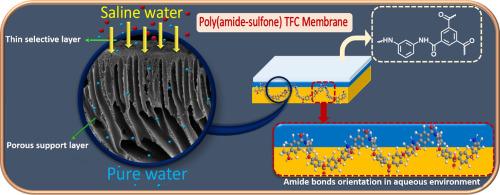Structure-performance relationship in tailored poly(amide-sulfone) membranes for desalination
IF 8.3
1区 工程技术
Q1 ENGINEERING, CHEMICAL
引用次数: 0
Abstract
Poly(amide-sulfone)s were considered the missing link for water desalination membranes, owing to their exceptional properties resulting from the synergism effects of two amide and sulfone structures. To achieve this, a sulfone-based diamine was first synthesized by reacting 4,4′-dichlorodiphenyl sulfone with 3-aminophenol. Subsequently, alternative copolymers of poly(amide-sulfone) were prepared via polycondensation reactions of the synthesized diamine monomer and various diacid chlorides including adipoyl dichloride, isophthaloyl dichloride, and terephthaloyl dichloride. The chemical structures were approved using Fourier transform infrared spectroscopy and hydrogen nuclear magnetic resonance spectroscopy. Porous membranes of the polymers as substrates were prepared by solution casting and phase-inversion method. To form thin film composite membranes, a thin polyamide layer was created through interfacial polymerization on the top surface of prepared substrates using m-phenylenediamine and trimesoyl chloride. After characterization, the performance of all membranes was assessed by evaluating pure water flux, NaCl rejection, and flux recovery ratio using a cross-flow filtration system. The impact of the amide group within the poly(amide-sulfone) substrate structure on thin-film efficiency was explored. Results, revealed that the structure significantly influenced membrane performance. Specifically, the highest pure water flux was 549.50 L.m−2.h−1. Also, NaCl rejection of 98.27 % and flux recovery ratio of 94.21 % were observed among them at pressure of 10 bar. This study provided valuable insights for developing novel poly(amide-sulfone) membranes tailored for desalination applications.

用于海水淡化的定制聚(酰胺-砜)膜的结构-性能关系
聚(酰胺-砜)被认为是海水淡化膜的缺失环节,因为它具有两种酰胺和砜结构协同作用所产生的特殊性能。为此,首先通过 4,4′-二氯二苯砜与 3-氨基苯酚反应合成了砜基二胺。随后,通过将合成的二胺单体与各种二酸酰氯(包括己二酰二氯、间苯二甲酰氯和对苯二甲酰氯)进行缩聚反应,制备出了聚酰胺-砜的替代共聚物。利用傅立叶变换红外光谱和氢核磁共振光谱对化学结构进行了鉴定。以这些聚合物为基材的多孔膜是通过溶液浇铸法和相变法制备的。为了形成薄膜复合膜,使用间苯二胺和三甲基甲酰氯通过界面聚合在制备好的基底上表面形成一层薄的聚酰胺层。表征完成后,通过使用错流过滤系统评估纯水通量、NaCl 排出量和通量回收率,对所有膜的性能进行了评估。研究还探讨了聚(酰胺-砜)基底结构中的酰胺基团对薄膜效率的影响。结果表明,结构对膜性能的影响很大。具体来说,最高纯水通量为 549.50 L.m-2.h-1。此外,在压力为 10 巴时,NaCl 的去除率为 98.27%,通量回收率为 94.21%。这项研究为开发适合海水淡化应用的新型聚(酰胺-砜)膜提供了宝贵的见解。
本文章由计算机程序翻译,如有差异,请以英文原文为准。
求助全文
约1分钟内获得全文
求助全文
来源期刊

Desalination
工程技术-工程:化工
CiteScore
14.60
自引率
20.20%
发文量
619
审稿时长
41 days
期刊介绍:
Desalination is a scholarly journal that focuses on the field of desalination materials, processes, and associated technologies. It encompasses a wide range of disciplines and aims to publish exceptional papers in this area.
The journal invites submissions that explicitly revolve around water desalting and its applications to various sources such as seawater, groundwater, and wastewater. It particularly encourages research on diverse desalination methods including thermal, membrane, sorption, and hybrid processes.
By providing a platform for innovative studies, Desalination aims to advance the understanding and development of desalination technologies, promoting sustainable solutions for water scarcity challenges.
 求助内容:
求助内容: 应助结果提醒方式:
应助结果提醒方式:


